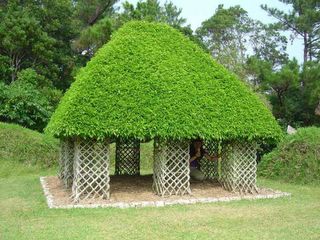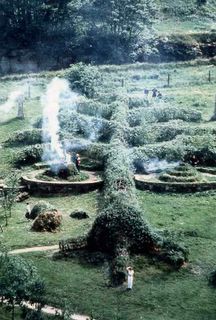The balance in these designs is the intensive training vs. "wild" growth. Trees provide shade and comfort in their natural state. What would be the minimal ammount of training one could do to gain the maximum ammount of shelter from living trees?
Planting location has been used for centuries to make living fences to keep cattle. The tradition in England of the Hawthorne fence required that the farmer "prune" the hedge when it got too wild by cutting long branches half way through, and bending them back into the hedge, not killing the branch. This form of pruning went out of fashion when mechanical verge mowers became available and now english hedge rows are being lost as the gaps get wider and wider every year. The art of this style of pruning is being lost.
A group of existing trees with tents underneath is a minimal approach. A maximal approach would have central heat and air plumbed throughout a living tree structure. I wonder how a tree would react to such temperature differential between inside and out?
For those inclined to garden, planting some trees in a pattern is fun. I can imagine that there are hundreds of people doing it all over the world at any one time. Planted and pruned living summer houses (fair weather structures) may in time become substantial structures used for more year round purposes. A series of such structures planted year after year would become a compound of BioStructures over time. Maintaining such structures is probably not a common skill. We were more collectively attuned to nature 100 years ago when 95% of all populations worked on farms. The sustainable development movent may educate new generations about living with nature in a less exploitive way than their predecestors did.
I picture an evolved coincidental arrangement derived from diminishing resources. The increased cost of gasoline will mean less and less mowing of lawns over time. What were once "manicured" subdivisions will become mini "semi-wild" forests with houses, roads and utilites intact. One hundred years into the future, these cheap pre-fab structures will no longer stand. Their wood frames however will make great training framework for ArborTecture.
This intensity of tree growth requires some human intervention. Trees don't voluntarily grow this close togeather.
Friday, March 24, 2006
Sanfte Strukturen

Sanfte Strukturen
These are some of the most artfull living structures I've seen. There's definitely no effort to conform to a conventional house use. They are fair weather community pavilions. Very artfull.
http://www.sanftestrukturen.de/

Appearently basket weaving is very similar to the skills needed to weave a living structure. This person makes scale models in basketry.
http://www.sanftestrukturen.de/html/modellbau.html
They stopped updating the photos in 2004. I hope the trees didn't die or something. (scroll the timeline for photos)
http://www.weidenschloss-bremerhaven.de/content/geschichte.htm
Arborsmith will do classes in NC
November 5-11, 2006To sign up, go to their web site http://www.folkschool.org
Dr. Lois Walpole
Dr. Lois Walpole of England
Weaves in organic and recyclable materials, has an installation at Kew Gardens. You're gonna need tables and chairs for that Tree House.
http://www.loiswalpole.com/default.htm
Prodotticulture
http://www.rbgkew.org.uk/whatsnew/coathanger.html
Weaves in organic and recyclable materials, has an installation at Kew Gardens. You're gonna need tables and chairs for that Tree House.
http://www.loiswalpole.com/default.htm
Prodotticulture
http://www.rbgkew.org.uk/whatsnew/coathanger.html
Subscribe to:
Comments (Atom)


